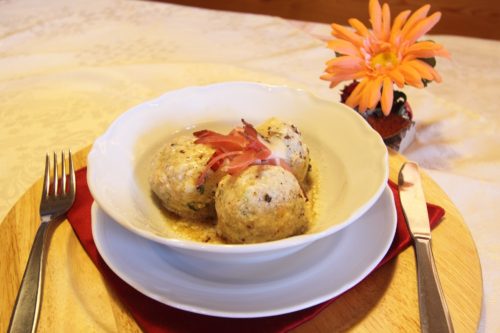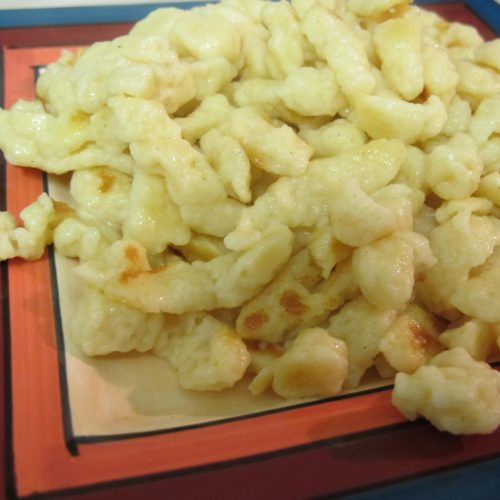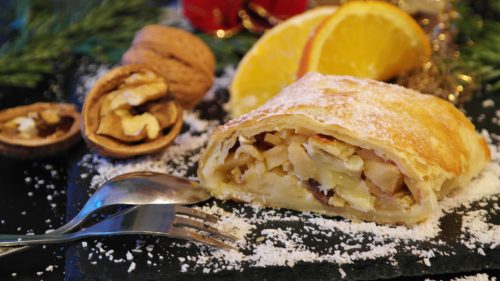Being an Italian region only since the end of World War One, located on the border with Switzerland and Austria, Trentino Alto-Adige is characterized by a unique combination of typical dishes. People coming from northern Europe will have a preview of the Mediterranean flavours they will encounter in their journey southwards, while those coming from the south will be surprised by hearty German and Austrian dishes, which are the core of South Tyrolean gastronomy. Trentino, the southern part of the region, has preserved the traditional recipes prepared by lower classes, based largely on polenta and vegetables, as well as the meat dishes that used to be served at the banquets of high-ranking figures. This strong dichotomy has resulted in a wide array of recipes that now part of the culinary tradition of this region.
Discover the culinary traditions of Trentino Alto-Adige with ScuolaScuola, with a special focus on three typical dishes
The cuisine of Trentino Alto-Adige is based on three staples, namely apples, speck and polenta, which are used to prepare simple yet savoury dishes. Apples need no introduction but they are an authentic symbol of Trentino Alto-Adige, traditionally grown in every valley and famous for their excellent quality. Another ancient and widespread element is polenta, enriched with different ingredients depending on the area and even made with different types of flour: in the Val di Non valley, it is made with a mixture of yellow cornmeal and buckwheat flour, while near Garda Lake it is made with white wheat flour and potatoes, but there is also a black variant, entirely made with buckwheat. Trentino Alto-Adige is also the home of speck – one of Italy’s most famous cold cuts. Hams are boned out, rubbed with a cure of bay and juniper, then they are smoked and aged.
Read on to discover the three typical dishes we have chosen for you.
Canederli

A dish of hot canederli
Among the most famous regional specialties of Trentino Alto-Adige are canederli, bread dumplings in a northern European style, traditionally served in broth or drizzled with butter. They are made with bread, milk, eggs, and flavoured with a wide variety of ingredients ranging from cold cuts such as speck or pancetta to cheese, from spinach to beetroot. Nowadays you can find them in many restaurants, pubs and alpine farmsteads, but they were born as a poor dish, prepared with stale bread. A fresco in the chapel of Hocheppan Castle, near Bolzano, shows a woman eating dumplings, which makes us suppose that canederli were known in Trentino Alto-Adige as early as the 13th century.
There is also a sweet variant, canederli con albicocche or marillenknodel, with apricot filling.
Spätzle

Spätzle are a typical type of pasta
These small gnocchi made with flour, fresh eggs, water are very common in Germany, Austria, Switzerland, and Trentino-Alto Adige of course. They are made with a tool called spätzlehobel, a sort of grater that gives them their distinctive shape, and cook quickly in boiling water. They can be white, green (with spinach), or red (with beetroot), and are served in many different ways, but one of the most typical versions is with cream sauce and speck.
Strudel

Do you know apple strudel?
No proper article about the gastronomic traditions of Trentino Alto-Adige can end without mentioning strudel. Strudel, a German word meaning whirlpool, is a crispy pastry filled with apples, raisins, pine nuts, buttered breadcrumbs, scented with cinnamon. Its ingredients are typical of this area but what is not widely known is that its origins are actually Turkish. As a matter of fact, it is a descendant of the ancient baklava, one of the most popular pastries of Ottoman cuisine, filled with nuts and sweetened with honey, and it became the dessert we know today when apples were added to the filling.
Discover more about Italian cuisine with ScuolaScuola
- Ciambellone di Pasqua
- Colomba di Pasqua
- Risi e bisi
- 5 menus for an Italian Christmas
- 5 popular Italian dishes

